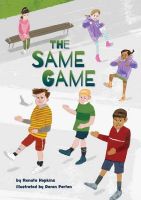These teacher notes provide activities to support teaching and learning about cultural diversity and inclusion in association with the big book The Same Game.
This is a book for “reading to” students. The first time you read this story to students, focus on enjoyment and understanding. In later readings, go deeper into the perspectives of the characters and the themes of diversity, inclusion, and empathy. The Same Game is intended to help foster the curriculum principles of diversity and inclusion by supporting students to recognise and appreciate their similarities and differences. Set in the familiar world of school, it will stimulate connections to students’ own experiences. It may even motivate them to take action to create a culture of belonging in their community.
_______________________________________________________________________________________
The New Zealand Curriculum: Principles
Cultural diversity
The curriculum reflects New Zealand’s cultural diversity and values the histories and traditions of all its people.
Inclusion
The curriculum is non-sexist, non-racist, and non-discriminatory; it ensures that students’ identities, languages, abilities, and talents are recognised and affirmed and that their learning needs are addressed.
_______________________________________________________________________________________
| Read The Same Game
| Talk about it
| Take action for diversity and inclusion
|
- Read the story to the students, beginning with a brief introduction. This story is about two girls who make up a new game. Let’s find out what happens.
- Read the story in an expressive way. Without interrupting the flow, use "think alouds" to prompt connections and foster empathy.
- I wonder what will happen…
- What will Lani do…?
- Poor Zoe. I know how that feels.
- That’s interesting. What are Kāhu and Jasmine planning?
- Encourage the students to make personal connections by sharing stories of similar experiences.
- This story makes me think about…
- What does it make you think about?
- Foster empathy by listing the characters’ names and asking the students to think about how the characters feel and how their feelings change. Write the feeling words under the relevant characters’ names. Prompts could include:
- How do you think the boys felt about their new game?
- You said something like this happened to you. Can you tell us how that felt?
- I wonder why Lani didn’t stand up to Lucy. How do you think she was feeling?
|
- Discuss the story’s message, drawing on the connections the students have made and their sense of empathy with the characters.
- What did you think of Jasmine and Kāhu’s version of the same game? What do you think they wanted the children to learn?
- Was that a good message?
- Is this the only way people can feel left out at school? What are some other ways people can feel left out?
- Discuss the concept of manaakitanga. Explain that manaakitanga means to “care for a person’s mana”. It means looking after people’s welfare and giving them respect.
- What are some ways people in our school show manaakitanga to each other?
- What could we do to make sure everybody in our class knows they belong and that we care about them?
- How could we make sure no one feels left out?
|
- Have the students try both versions of the same game, then talk about how it felt.
- Which did you most enjoy?
- Can you think of games we play that we could change so everyone can take part?
- Maybe we could make up a new game where everyone has to participate for it to work out?
- Have the students create freeze-frame images, using their bodies and facial expressions to capture moments from the story. They could take turns as actors, directors, and photographers. Have the students take photos of the freeze-frames then ask them to write captions describing what they did and what the photos show. Or explore how to move from one still image to another, creating a story that could be performed for others.
- Create a role play with a changed ending. What might have happened if Lucy had let the boys join the game at morning break?
- Create a big mural showing the kinds of things that happen in a school where everybody feels like they belong. Present the mural at assembly.
- Support the students to take action on one of their ideas for creating a culture of belonging and manaakitanga.
|
_______________________________________________________________________________________
Where to go for more information
The cultural diversity and inclusion sections of Curriculum Online draw together research, digital resources, and examples to support schools as they consider these closely linked principles. See especially the Cultural diversity spotlight and the guide on Developing an inclusive classroom culture.
http://nzcurriculum.tki.org.nz/Principles/Cultural-diversity
https://nzcurriculum.tki.org.nz/Principles/Inclusion
http://nzcurriculum.tki.org.nz/Curriculum-resources/Spotlights/Cultural-diversity
https://www.inclusive.tki.org.nz/guides/developing-an-inclusive-classroom-culture
_______________________________________________________________________________________
Download these teacher notes:


